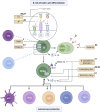Traditional Chinese medicine for lupus nephritis: modulation of autoimmune pathogenesis
- PMID: 40385489
- PMCID: PMC12083088
- DOI: 10.3389/fphar.2025.1523272
Traditional Chinese medicine for lupus nephritis: modulation of autoimmune pathogenesis
Abstract
Ethnopharmacological relevance: Lupus nephritis (LN) is an immune complex glomerulonephritis commonly associated with systemic lupus erythematosus. Traditional Chinese medicine (TCM) has emerged as a promising adjuvant therapy for LN, due to its low toxicity and diverse therapeutic effects for long-term management.
Materials and methods: A comprehensive search of PubMed and Web of Science was conducted up to 7 June 2024, using keywords related to lupus nephritis, traditional Chinese medicine, immune cells, and kidney resident cells. Study quality were assessed based on Good Automated Manufacturing Practice guidelines, with evaluations jointly conducted by two authors.
Results: This review includes 31 research papers and summarizes seven herbal formulas and 18 phytochemicals that modulate the autoimmune pathogenesis of LN. Their mechanisms involve regulating immune cells activation, differentiation, apoptosis, as well as influencing resident kidney cells to support renal protection and immune homeostasis. Since TCM exhibit bidirectional regulation, they activate regulatory immune cells while suppress pathogenic factors. Inconsistent or inconclusive findings are discussed.
Conclusion: This review summarizes current research on herbal formulas and phytochemicals in immune cells and kidney resident cells in LN, highlighting the potential and significance of TCM treatment. It also addresses the limitations of existing studies and suggests that future research should focus on exploring the immunosuppressive and kidney-protective effects of herbal formulas and phytochemicals, as well as enhancing the clinical translation and standardization of TCM.
Keywords: Chinese herbal; herbal formula; immune system; lupus nephritis; plant extracts; systemic lupus erythematosus.
Copyright © 2025 Huang, Li, Zhu, Zhu, Fan and Zhao.
Conflict of interest statement
The authors declare that the research was conducted in the absence of any commercial or financial relationships that could be construed as a potential conflict of interest.
Figures



Similar articles
-
Role of Traditional Chinese Medicine for the Treatment of Lupus nephritis: Mechanisms and Applications.Altern Ther Health Med. 2024 Jun;30(6):154-165. Altern Ther Health Med. 2024. PMID: 37944951 Review.
-
Application of herbal traditional Chinese medicine in the treatment of lupus nephritis.Front Pharmacol. 2022 Nov 24;13:981063. doi: 10.3389/fphar.2022.981063. eCollection 2022. Front Pharmacol. 2022. PMID: 36506523 Free PMC article. Review.
-
Mechanism of Traditional Chinese Medicine extract in the treatment of diabetic erectile dysfunction.J Ethnopharmacol. 2025 Feb 11;341:119332. doi: 10.1016/j.jep.2025.119332. Epub 2025 Jan 6. J Ethnopharmacol. 2025. PMID: 39778785 Review.
-
Traditional Chinese medicine formulas for the treatment of osteoporosis: Implication for antiosteoporotic drug discovery.J Ethnopharmacol. 2016 Aug 2;189:61-80. doi: 10.1016/j.jep.2016.05.025. Epub 2016 May 11. J Ethnopharmacol. 2016. PMID: 27180315 Review.
-
Progress in traditional Chinese medicine and natural extracts for the treatment of lupus nephritis.Biomed Pharmacother. 2022 May;149:112799. doi: 10.1016/j.biopha.2022.112799. Epub 2022 Mar 9. Biomed Pharmacother. 2022. PMID: 35279011 Review.
References
-
- Astry B., Venkatesha S. H., Laurence A., Christensen-Quick A., Garzino-Demo A., Frieman M. B., et al. (2015). Celastrol, a Chinese herbal compound, controls autoimmune inflammation by altering the balance of pathogenic and regulatory T cells in the target organ. Clin. Immunol. 157 (2), 228–238. 10.1016/j.clim.2015.01.011 - DOI - PMC - PubMed
Publication types
LinkOut - more resources
Full Text Sources

